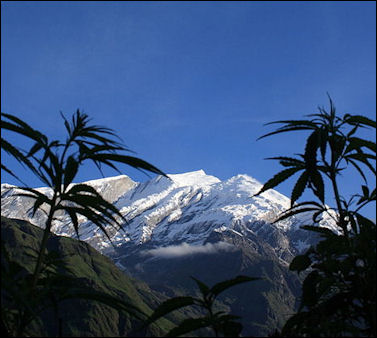CANNABIS AGRICULTURE
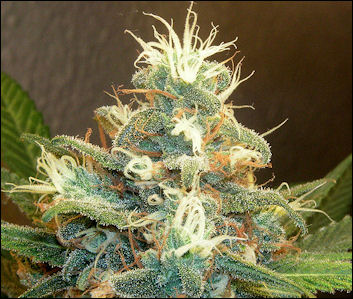
Dreamy Weed Cannabis is one of the most diversified and widespread plants. It grows as a weed and is cultivated in a variety of climates and soils. It needs relatively little water and is resistant to drought. An estimated 50,000 tons of marijuana and hashish is produced very year.
Cannabis generally brings a grower at least $4,000 per acre and can cost as little as $100 to maintain and entire field. By contrast growing a field of onions can cost a farmer $500 and bring in only $100 if the farmer can find a buyer. One farmer told the Los Angeles Times, “To us, this is just a crop. I would rather plant melons, but customers are always ready to buy hashish.”
The potency of cannabis is influenced by the genetic make up of the plant (having good quality seeds is essential for growing good quality stuff), climate, soil, growing conditions, timing of the harvest and drying and storing techniques. Many marijuana and hashish producers say that like wine grapes the taste and potency of their crops improves in dry years.
As the cannabis plant matures cannabidiolic acid changes to cannabidiol, which in turn changes to THC when the plant reaches its floral peak. As the plant goes into the late floral stage THC changes into cannabinol. The idea is to harvest the plant when the THC is at its peak. Cannabis that is harvested at this peak is said to produce a “clean” and “clear” high. Cannabis that is harvested past this peak is said to produce a more sleepy “stoned” high.
According to the UNODC: In the past two decades, there have been rapid advances in cannabis plant cultivation techniques, in particular in Europe and North America, which are mainly focused on achieving a high Δ9-THC content. In addition to the major transformation of cannabis cultivation in recent years, the cannabis market has diversified to the extent that it now comprises a broad range of products with varying means of ingestion, potency and effects. [Source: United Nations Office on Drugs and Crime (UNODC), World Drug Report 2021]
See Separate Articles CANNABIS (MARIJUANA): HISTORY, CHEMICALS, PRODUCTS AND GETTING HIGH factsanddetails.com ; HASHISH: HISTORY, TYPES AND PRODUCTION factsanddetails.com ; CANNABIS (MARIJUANA) HEALTH AND LAWS factsanddetails.com
Websites and Resources: U.S. Drug Enforcement Administration (DEA) justice.gov/dea/concern ; Vaults of Erowid erowid.org ; United Nations Office of Drugs and Crime (UNODC) unodc.org ; Wikipedia article on illegal drug trade Wikipedia ; Frank’s A-to-Z on Drugs talktofrank.com ; Streetdrugs.org streetdrugs.org ; Illegal Drugs, country by country listing, CIA cia.gov/library/publications/the-world-factbook
Books: “Buzzed” by Cynthia Kuhn Ph.D. Scott Swartzwelder, Ph.D., Wilkie Wilson Ph.D. of the Duke University Medical Center (Norton, 2003); “Consuming Habits: Drugs in Anthropology and History” by Goodman, Sharratt and Lovejoy; “Drug War Heresies: Learning from Other Vices, Times and Places” by Robert MacCoun and Peter Reuter (Cambridge University Press).
Cannabis Plant

Cannabis sativa plant The Cannabis plant is an annual herb variously described as belonging to the nettles, mulberry or hops families of plants. There are male and female plants. The female plant is the primary source of marijuana and hashish. It has denser foliage and is taller than the male plant. It also has the desirable buds, which contains high amounts of THC. The roots of cannabis can stretch down two meters or more, and serve as important soil stabilizers, particularly where sandy, semi-arid soils predominate such as in much of Central Asia.
It had long been thought that there were two main species of cannabis plant: “Cannabis sativa” and “Cannabis indica”. “Cannabis sativa” , the most widespread of the two, is tall, gangly and loosely branched and can reach a height if 20 feet. “Cannabis indica” is pyramidal in shape, bushy and dense and generally only reaches a height of three or four feet. The two kinds of plants have difference in their leaves, stems and resin. Even so some botanist consider them to be similar enough to be regarded as subspecies rather than species. They can interbreed and produce fertile offspring.
There is a debate as to how many cannabis species and subspecies there. “Cannabis sativa “ is a source of intoxicants and hemp. It is native to Central Asia and growing wild in places as diverse as Nigeria, Poland. “Cannabis indica” is a source of intoxicants. It is native to the Himalayan regions and found mostly in Afghanistan and Morocco, where it is used to make hashish. Indica plants have traditionally had higher THC content than sativa plants.
A third species or subspecies, “cannabis ruderalis” , has only minimal amounts of THC. A newly discovered subspecies, “Cannabis sativa rasta” , is similar to Cannabis sativa but has higher levels of THC. Many plants in Jamaica, Mexico and Africa are of this variety.
Mahmoud Elsohly of the Marijuana Project at the University of Mississippi told the New York Times, there is “only one species of cannabis. It had always been thought there were many. You could see that the chemistry of this plant is the same qualitatively no matter where it comes from. What makes each different is the relative proportion of the different chemicals in there, which doesn’t make a different species. It’s really the same species, but different variations of it. The different types of varieties hybridize very easily.
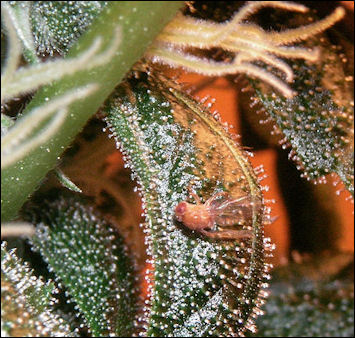
Insect stuck on cannabis trichomesOn whether cannabis can be genetically modified Elsohly said, “Absolutely.. That actually has been the trend over the years in cultivation in the illicit market, and also in the legal market, where we are doing genetic selection, where we select specific materials that have the genes that produce higher levels of THC or some other ingredients.” In northern California “they have been doing genetic selection for years, You can see the potency keeps going up. In the 1970s, the seized cannabis had probably 1 percent active ingredient. Now, its almost 8 percent , on the average.”
THC-Producing Parts of the Cannabis Plant
Cannabis buds, where most of the THC, is concentrated grow at the top of the plants and the ends of the upper branches. They are a combination of small densely packed leaves, flowers and resin-producing epidermal glands called trichomes. The highest THC concentrations are found in the resins and in the trichomes, which that often look like orange and red hairs are often incorrectly referred to as “pollen” or “crystals.”
The sticky resin that gets people high is thought to offer the plant protection from heat and preserve moisture during reproduction. Before breeding and tinkering with cannabis plants began, the plants with the highest THC came from hot regions like Mexico, the Middle East and India or in high mountainous areas. The reasoning goes that at high altitudes and in the desert exposed high levels of sunlight and ultraviolet radiation produces large amounts of THC. Maybe one reason why the hashish from Afghanistan has traditionally been so good is that it comes from plants grown in both very high and very dry areas.
The chemical structure of THC was only discovered in 1964. The cannabis used to make marijuana and hashish typically has a THC content of between 3 percent and 20 percent. Some super high grade stuff has a THC content of 30 percent. By contrast, cannabis that is used to make hemp has a THC content of less than one percent.
Cannabis Cultivation
Growing cannabis is very easy. Regarded as a weed, it needs relatively little care and requires little or no herbicide. Farmers simply make sure they have some good seeds and the soil has enough nitrogen. Many farmers simply throw some seeds in the soil, water it a little and watch it grow, without fertilizers or pesticides.
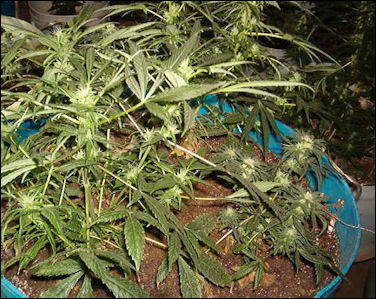
Cannabis in Kentucky One essential step in growing high-quality cannabis is removing all the male plants. With the male plants gone the buds on the female plants are not pollinated. They get bigger and denser and increase their THC content. If male plants are present they pollinate te female plants and the buds began producing seeds. Seeds don’t contain much THC and are unpleasant to smoke. Once the seeds are ripe the female plant stops producing resin and THC production and potency start to drop off.
Harvesting is simple. The flowering tops are picked and placed on nets and hung to dry for about a week. The dried buds are peeled off and placed in baggies. In northern California the cannabis crop is harvested in October.
These days much of the cannabis consumed in Europe and North America is grown locally. Because of bulkiness and relatively low market value (compared to other drugs), cannabis is best grown near its market. Smuggling marijuana is much more difficult than smuggling cocaine or heroin or even hashish which are more concentrated and compact.
Much of the cannabis consumed in Western countries is grown in basements, closets or otherwise empty rooms under grow lights, in greenhouses, or in farm fields mixed in with other crops. Many of those who grow it indoors use the latest, controlled, hydroponic cultivation techniques that produce higher THC levels.
Charas (Hashish) Cultivation and Production in Nepal
High quality charas (hashish) is produced in Nepal. It used to sold in government monopoly stores in Kathmandu. The Rolpa district in western Nepal was a production center. Ganja and charas were important cash crop, providing a much needed source of income in an extremely isolated, underdeveloped and impoverished region. In Nepal, charas is produced by hand-rubbing fresh plants. Harvesters first thoroughly wash their hands and let them dry in the sun. Then start rubbing the fresh colas of the female plants until a thick layer of resin glands covers their palms. They then scrape off and collect the resin and repeat the process, this time collecting a second-grade resin. After they finish rubbing the plants, the resin is rolled with hands into shiny spheres round (friction and heat really help) as round pieces, commonly called Temple Balls. After leaving them to stand for some days, they’re ready to be enjoyed!
In the higher elevation of Darchula District in northwest Nepal provide, all three major products of the cannabis plant — seeds and resin from the female flowers as well as fiber from the stems — are extracted from the same crop. Describing the cultivation of cannabis and production of charas there, Robert Connell Clarke of the International Hemp Association wrote: “Cannabis crops share terraced fields with other “grain” crops such as wheat, maize and amaranth, field crops like squashes, chilies, tomatoes, root crops like potatoes and radishes and apple, pear and plum trees. Cannabis is the only cultivated fiber plant in Darchula District.Most households usually grow one to several relatively small Cannabis fields of 10-200 square meters. Fields are sown at high density to encourage the plants to grow tall, straight and without branches so the stalks will be suitable for fiber extraction. Manure is added to the fields and they are plowed thoroughly to make the soil as fine and aerated as possible. Seed is broadcast sown when the soil has warmed sufficiently, some time in late May through early July. Additional fertilizer may be added when the seed is sown, but no nutrients are added after the seeds germinate, and the crop is not irrigated, as it receives sufficient water from localized spring rainfall and the summer monsoons. Occasionally crops are also sown at wider spacing, which requires less seed and encourages the plants to branch. [Source: Robert Connell Clarke, International Hemp Association“Traditional Cannabis Cultivation in Darchula District, Nepal — Seed, Resin and Textiles.” Journal of Industrial Hemp, November 2007]
Cannabis growing in front of
Dhaulagiri in Nepal“Mature plants are harvested in October through early December, commencing a few weeks after the last monsoon rains. Plants are harvested in the morning after the dew evaporates, beginning with the larger spontaneously growing plants. Flowering branches are cut from the plants and rubbed to collect the resin (charas) before they are dried in the sun and the seeds threshed out. Once the spontaneous plants are harvested the farmers begin to cut the ripe fields sown for fiber production.
“Throughout the afternoon entire families will sit and collect charas by first tearing the large leaves from the floral clusters and then strip ping the floral clusters from the stalk. The flowers are aggressively rubbed between the hands so that the psychoactive resin (as well as extraneous dust, plant juice, leaf fragments and insect parts) adhere to the palms and fingers. One person can collect from five to ten grams of potent higher quality charas in a day, but more commonly 20-30 grams of lower quality charas containing more extraneous plant juices and tissues is rubbed each day. Rubbing Cannabis flowers by hand is very simple and this extraction technique was likely the first used by ancient agricultural societies to collect resin. Hand-rubbed charas is also produced in the Malana and Manali regions of Kulu District of the Indian Himalayan state of Himachal Pradesh, northwest of Uttaranchal State, but it is presently uncommon outside the Himalayan foothill region.
Charas is most often smoked in a conical clay pipe called a chillum, but may also be infused into hot milk and drunk as bhang. Charas is only rarely consumed by farmers, who rely on it for important income, and most often choose to sell whatever they produce. A 100 square meter cannabis field can yield up to 200 grams of charas, which sells for approximately US$28, as well as about ten kilograms of seed worth a minimum of US$0.55 per kilogram. So, the total economic benefit from a well grown and efficiently harvested and extracted 100 square meter crop ranges between US$25-40, which is roughly equivalent to US$2,500-4,000 per hectare and based on the projected area of hemp/charas/seed cultivation, the annual production of cultivated charas is conservatively estimated to exceed 500 kilograms and may be much higher. When charas collected from feral plants is included, production in the upper Darchula region may exceed one metric ton.
Global Cannabis Cultivation
According to the UNODC: Cannabis cultivation and production affects all regions Unlike other plant-based drugs, for which cultivation and production are concentrated in only a few countries, cannabis is produced in almost all countries worldwide. Qualitative information on trends reported by Member States suggests that there was an expansion in global cannabis cultivation over the period 2010–2017, followed by a decline in 2018 and then a moderate increase in 2019. Global seizures in 2019 for cannabis herb (marijuana) were 3,779 tons, down 12 percent from the previous years, and 1,395 tons for cannabis resin (hashish), up seven percent from 2018. Outdoor cultivation of cannabis continues to be more widespread than indoor cultivation, but the increase in indoor cultivation About 65 million tons of cannabis was grown in 2008, with Morocco, Paraguay, Mexico and the United States being the top producing countries. [Source: United Nations Office on Drugs and Crime (UNODC), World Drug Report 2021]
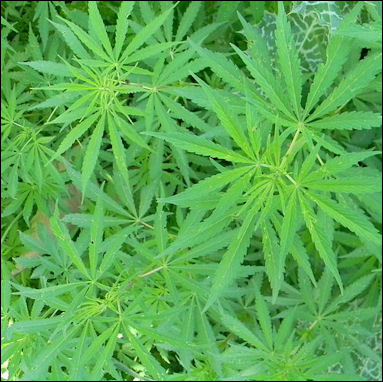
Cannabis from Pakistan Available data suggest that outdoor cannabis cultivation continues to be more widespread at the global level than indoor cannabis cultivation, a situation that did not change between the periods 2010–2014 and 2015–2019. Overall, 89 countries reported outdoor cannabis cultivation and/or law enforcement activities linked to outdoor cannabis cultivation (such as eradication, seizures of cannabis plants and seizures of cannabis-producing sites) in the period 2010–2019, while 65 countries reported data in relation to indoor cultivation. Some countries reported both indoor and outdoor cannabis cultivation.
Whereas outdoor cannabis production is found around the globe, most reported indoor cultivation of cannabis continues to be concentrated in countries of Europe and North America (most notably the United States, followed by Canada) and, to a lesser extent, in countries of Central and South America (including Chile, Colombia, Ecuador and Uruguay). Beyond those regions, indoor cannabis cultivation is found in Oceania (Australia and New Zealand) as well as in a number of countries and territories in Asia, including in the Near and Middle East/South-West Asia (Iran (Islamic Republic of), Israel and the State of Palestine), in East and South-East Asia (China, including Hong Kong, China, Japan and Mongolia), in Central Asia (Kyrgyzstan and Uzbekistan) and Transcaucasia (Armenia and Georgia). To date, no indoor cannabis cultivation has been reported to UNODC by countries in Africa.
Qualitative information on trends reported by Member States also suggests that over the period 2012–2019, the increase in indoor cannabis cultivation was larger than the increase in outdoor cultivation. In that period, 49 countries (43 per cent of the countries that reported trends in indoor cultivation) reported an increase in indoor cultivation, while 23 countries (20 per cent) reported a decrease, resulting in overall “net growth” of 23 per cent among all countries that reported indoor cannabis cultivation trends. That is more than three times the corresponding “net growth” in the proportion of countries that reported outdoor cannabis cultivation trends (7 per cent). Most of the increases in indoor cannabis cultivation were reported by countries in Europe and, to a lesser extent, by countries in the Americas.
Source Countries for Cannabis
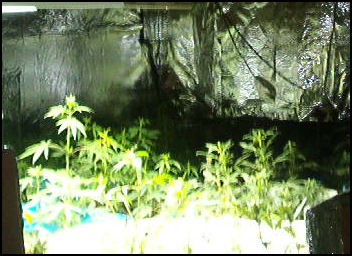
indoor growing Because cannabis is still illegal in most countries and growing it is illegal, it is hard to determine exactly how much cannabis is produced. The United Nations Office on Drugs and Crime tries each year, reporting its findings in its annual World Drug Report, “either through direct indicators (such as the cultivation or eradication of cannabis plants and the dismantlement of cannabis-producing sites) or indirect indicators (such as the seizure of cannabis plants and the origin of cannabis seizures as reported by other Member States) by 151 countries, covering 97 per cent of the global population.
According to the UNODC: As most countries do not have systems in place to systematically monitor the area under cannabis cultivation, estimating the global area under cannabis cultivation is challenging. On the one hand, some countries report the total area under cannabis cultivation, but such estimates have severe limitations; on the other hand, existing indicators on seizures and eradication are widely available. Any indicator as it relates to a single country is insufficient to provide insight into the extent of cannabis cultivation and production, but when the indicators for various countries are analysed together, they can point to those countries where the most significant cannabis cultivation is likely to exist.a Analysis of the various indicators over the period 2010–2019 suggests that the following countries are likely to have a significant area under cannabis cultivation in comparison with other countries in the same region or subregion (given in order of importance, for each subregion):
Major cannabis-producing countries in major regions: North America: Mexico, the United States of America and Canada; South America: Paraguay, Brazil and Colombia; Central America: Guatemala, Costa Rica and Honduras; Caribbean: Jamaica and Trinidad and Tobago Africa: Morocco, Egypt, South Africa, Nigeria, Eswatini and Ghana; Western and Central Europe: the Netherlands, Spain, Czechia and Switzerland; South-Eastern Europe: Albania, Turkey and Romania; Eastern Europe: the Russian Federation and Ukraine; Near and Middle East/South-West Asia: Afghanistan, Lebanon and Pakistan; Central Asia: Kyrgyzstan and Kazakhstan; Transcaucasia: Azerbaijan and Armenia; South Asia: India and Nepal; Southeast Asia: the Philippines,Laos, Thailand and Indonesia; Oceania: Australia and New Zealand
Dr. Jason West of the University of Utah has developed a way to determine the point of origin of cannabis by measuring the ratios of stable hydrogen, nitrogen, carbon and oxygen isotopes found in the leaves. The ratio of stable hydrogen isotopes, for example, can be matched to the local water in a particular region with the same ratio. West can also determine other things like whether the drug was grown inside or outside, what fertilizers were used and amount of rain and sun using nitrogen and carbon isotopes. The research is being done in part because less is known about cannabis movement within the United States than about heroin and cocaine movement.
Largest Cannabis-Producing Countries
1) The United States is the largest producer of cannabis in the world. It is a popular recreational drug and medical drug and 26 states have legalized or decriminalized it. Even so, the sale and possession of cannabis is illegal under federal law and the drug is still illegal in many states. There are thousands of places that grow it and sell it. Drugstore chains such as Walgreens Boot Alliance and CVS Health Corp. selling CBD products in their stores. [Source: RTT News]
2) Morocco has been cultivated cannabis centuries. In the early 2000s, 70 percent of hashish consumed in Europe was produced in Morocco despite cannabis being illegal in Morocco. Production is centered mainly in mountainous Rif region. Because cannabis makes up such share of the economy many favor of legalizing cannabis in Morocco.
3) Afghanistan has cultivated cannabis for centuries too and was a top destination on the hippie trail in the 1970s.. The cannabis Indica plant is native to Afghanistan as well as India. In 2010, the country was the world’s largest cannabis supplier. Over the years, cannabis, along with opium, cultivation has been an important source of income for the Taliban.

indoor growing
4) Mexico has historically been a leading cannabis producer. The the word “marijuana” originated in Mexico. Cannabis was introduced to Mexico by the Spanish in the 16th century, in the form of hemp. Personal possession of small amounts of cannabis was decriminalized by Mexico in 2009 in part to reduce the power of the drug cartels. Medical use for cannabis with a THC content less than one percent was legalized in 2017.
5) Colombia has long been major producer of cannabis along with cocaine. Cannabis cultivation dates back the late colonial period, when hemp was grown for industrial fibers. In 2012, the Colombian government decriminalized the possession of less than 20 grams of cannabis. In 2015, the Colombian Supreme Court ruled that cultivation of 20 cannabis plants or less was okay. The drug was legalized for medical use in 2015.
6) Paraguay is the second-largest cannabis producer in Latin America even though cannabis is illegal there. Paraguay is a major source of cannabis in Latin America and possession of ten grams or less was decriminalized in Paraguay in 1988.
7) Jamaica is the largest Caribbean producer cannabis. Introduced to Jamaica in the mid-nineteenth century by indentured Indian servants brought by British colonists, cannabis has a strong association with Jamaica and its Rastafarian religion and reggae music. Many of the cannabis terms used in Jamaica, such as ganja, come from India. Cannabis is still illegal in Jamaica but possession of small amounts of cannabis was was reduced to a minor offense in 2015.
8) Cannabis in Canada is legal for both recreational and medicinal purposes. Medicinal use of cannabis was legalized in Canada in 2001. In 2018, Canada became the second country in the world, after Uruguay, to formally legalize the cultivation, possession, acquisition and consumption of cannabis and its by-products. There are many online-sales operations and stores that sell cannabis. Canada is home to many of the world’s largest cannabis companies.
9) Nigeria is a major source of cannabis consumed in West Africa. The drug is widely used in Nigeria despite being illegal. There are no allowances for medical use. Possession of cannabis is punishable by a minimum sentence of 12 years in prison.
10) India boasts cannabis use that dates to 2000 B.C. Cannabis Indica is named after the plant specimens that were first collected in India. Charas (for hashish), ganja (buds) and bhang (seeds and leaves), bhang lassi (yoghurt-based cannabis drink) and bhang thandai (cannabis milkshake) are terms known to all Indians. According to the UNODC’s World Drug Report in 2016, India has the lowest cannabis prices in the world.
Marijuana Production in the United States
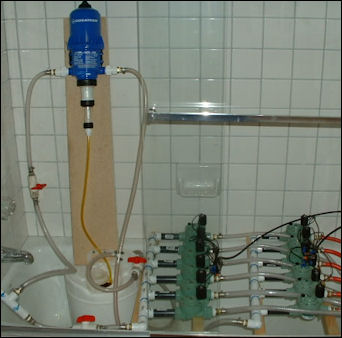
indoor growing stuff
Marijuana is one of the biggest cash crops in the United States, and even more so Canada, particularly in British Columbia. In the United States, sales of legal recreational cannabis was $7.4 billion in 2019 and $14.9 billion in 2021 and is expected to reach an estimated $25 billion by 2025. America's top-selling marijuana states in 2020: 1) California: $3.8 billion (recreational and medical mix); 2) Colorado: $1.7 billion ($1.4 billion recreational, $0.3 billion medical); 3) Michigan: $1.21 billion ($299 million recreational, $909 million medical); 4) Florida: $1.2 billion (all medical); 5) Washington: $1.1 billion (recreational and medical mix); 6) Nevada: $960 million ($900 million recreational, $60 million medical); 7) Oregon: $831 million ($796 million recreational, $35 million medical); 8) Arizona: $804 million (all medical); 9) Massachusetts: $682 million ($451 million recreational, $231 million medical); 10) Illinois: $543 million ($270 million recreational, $273 million medical). [Source: Statista, Motley Fool]
In terms of which states produce the most cannabis, Efstathios Martinis wrote in Quora.com in 2017: California produces the most weed. It has a climate very suitable for growth plus it has the largest population. Production in 2006: 1) California — around 8 million pounds; 2) Tennessee — about 3 million pounds; 3) Kentucky; and 4) Hawaii The estimates shown according to 2006 are estimates of known growers. These are merely estimates. Since marijuana was illegal in 2006. The amount of weed grown known is most likely much much higher. Possibly double the numbers published. Currently Oregon, Washington State and Nevada will be generating at least as much as those California numbers of 2006 in order to supply the greater or “higher” demand.
Oklahoma is now a major producer of cannabis due in part to its lax regulations. A statewide ballot initiative legalized medical marijuana there in 2018. NBC reports: Since then, dispensaries have become as ubiquitous as gas stations and churches in much of Oklahoma, where state officials have licensed more than 12,000 marijuana-related businesses and about 1 in 10 people now own medical marijuana cards. [Source: Graham Lee Brewer and Alicia Victoria Lozano, NBC News, February 9, 2022]
In the United States, cannabis is grown everywhere. In the 1990s and early 2000s California and Kentucky had a reputation for producing a lot and most of the marijuana consumed in the United States was grown domestically in six states: California, Hawaii, Kentucky, Oregon, Tennessee and Washington. Large amount also came from Mexico and Canada. At that time some outdoor farms in California covered several hundred acres and had more than 50,000 plants, each valued at around $4,000 each. Many farm were in national parks and national forests. The plants were planted six feet a part in the forest in places where they got good sunlight but could not be observed by aerial surveillance. The more sophisticated farms have diverted streams for water and use drip irrigation. Some farms were run by Mexican gangs. They hired workers who were dropped off using remote forest or logging roads. They slept in tents and guarded and took care of the plants during the summer growing season. Every two are three weeks new supplies were brought in for them. These days much of the U.S. cannabis crop is grown indoors in huge warehouse-like buildings.
Cannabis Eradication Efforts in Morocco
Paraquat is a toxic chemical that is widely used as an herbicide (plant killer), primarily for weed and grass control. It has been sprayed on cannabis fields as part eradication efforts. The Montana-based company Ag/Bio Con Inc. has bioengineered a fungus that attacks only cannabis. Drug enforcement people like the idea. Drug users and environmentalists are worried.
Efforts to crackdown on the drug trade in Morocco, whose economy relies on keif and hashish sales, have largely been comprised of token raids and arrests around harvest time. According to the report by the Geopolitical Drug Observatory released in the mid-1990s: “The political will to attack drug trafficking appears to be limited to announcements designed to maintain the country’s image.” According to U.S. State Department report, the Moroccan government has devoted “significant resources” to drug interdiction but large scale drug producers and traffickers operate “with virtual impunity” due to government “budgetary constraints, corruption and nearly exclusive focus of authorities on lower-level couriers.”
King Hassan’s drug fighting efforts often consisted of begging the E.U. for money to develop the Rif mountain region, where most of the cannabis comes from. In the mid 1990s, he proposed spending $100 million a year on developing the area with the E.U. kicking in $500 million a year. King Mohammed VI has done little to stop the drug trade even though he has been pressured to do so by the European Union. One grower told the Independent, that after King Mohammed VI took the throne the token raids and arrests around harvest time stopped. Talks between the European Union and Morocco to crackdown on the drug trade have yielded few results. An E.U. plan to get cannabis farmers around Ketama to switch to goats was abandoned after discovering that cannabis was simply grown in other places.

On average Spanish customs officials seize around 100 tons of hashish a year, much of from intercepted boats in the Straits of Gibralter but they have trouble intercepting drugs as they are often preoccupied with stopping illegal immigrants who also arrive by boat. In old days much of the cannabis crop of Morocco was bought by the French government. "Authorities buy up crops to destroy them,” one official told National Geographic, "This helps cut down drug traffic without completely crippling the farmers, already among the poorest in the land. For many, the drug is the only cash crop. The Rif is rugged country. Most of it is not reachable by motor road: to enforce prohibition, we would need an army."
Crack Down and Return of Hashish Agriculture in Lebanon
In the mid 1990s, the Lebanese government launched an drug eradication program. Cannabis plants were uprooted and burned by the Syrian and Lebanese armies. Poisons and chemicals were poured on thousands of acres of cannabis fields. Drug lords were forced to sell their villas and the militias disbanded. Programs were set up to encourage cannabis growers to raise other crops like tobacco, tomatoes, wheat, sugar beets, potatoes, and watermelon. The programs were poorly run and ran out of money not long after they were started. Funding for the main program dropped from $300 million to $4.25 million in a five year period.
Some farmers that were initially given a ton of potato seeds had the allotment suddenly cut to a half ton. Others were given American cows that failed to produce the promised amounts of milk under the weather and agricultural conditions in Lebanon. Those that successfully grew crops had difficulty finding buyers. Farmers suffered. They didn’t make nearly the money they used to and had to find other sources of income. Some became drivers. Sons were unable to get married because they couldn’t raise the bride price. When they did get married they were often forced to live at home.
By the late 2000s, cannabis had made a come back. Farmers grew fields of cannabis shielded from view by a few meters of corn plants placed around the perimeter of the field. If the were questioned by authorities they said they were growing the plants for bird seed. Much of the trade was controlled by the Jaffer tribes, who are heavily armed and used gun gunmen to patrol fields. Some of the growers were believed to be working with guerillas and Islamists, who needed money for their operations.
The government dropped leaflets from helicopters warning people not to grow cannabis. It worried that if the drug market returned to Lebanon in a big way the country could lose badly-needed foreign aid money. Even so, the government took little direct action to stop cannabis farming.
Image Source: DEA (Drug Enforcement Administration); Wikimedia Commons
Text Sources: 1) “Buzzed, the Straight Facts About the Most Used and Abused Drugs from Alcohol to Ecstasy” by Cynthia Kuhn, Ph.D., Scott Swartzwelder Ph.D., Wilkie Wilson Ph.D., Duke University Medical Center (W.W. Norton, New York, 2003); 2) National Institute on Drug Abuse, National Institutes of Health, U.S. Department of Health and Human Services; 3) United Nations Office on Drugs and Crime (UNODC) and 4) National Geographic, New York Times, Washington Post, Los Angeles Times, Wikipedia, The Independent, Times of London, The New Yorker, Time, Newsweek, Reuters, Associated Press, AFP, , Lonely Planet Guides, and various books and other publications.
Last updated April 2022

